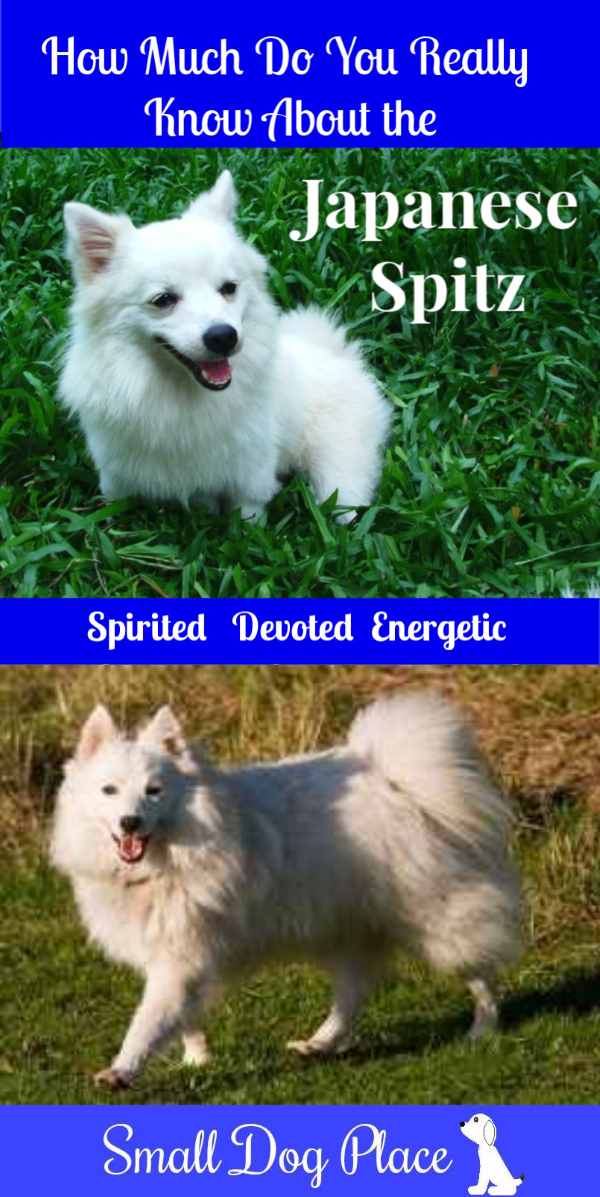The Japanese Spitz: Not a Mini Samoyed!
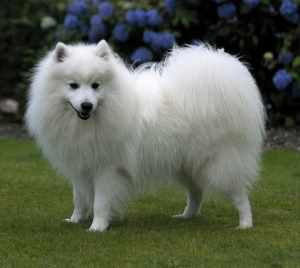
Take a quick peek at the Japanese Spitz, the Pomeranian, the American Eskimo and the Samoyed, and you might wonder if they aren’t all the same breed.
Looks can be deceiving and in fact, all of these Nordic type Spitz dogs are different breeds.
What is similar is the fact that these dogs, along with other breeds such as the German Spitz, Keeshound, and Malamute all belong the same Spitz family.
All Spitz dogs have similar characteristics.
They all have triangular heads, small erect ears and pointed muzzles. Their coats are medium to long and all have a tail that is carried over their back.
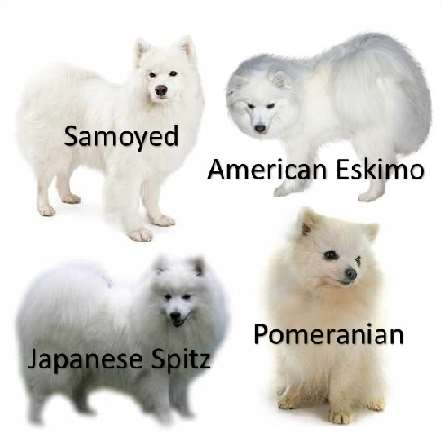 Nordic Spitz Breeds
Nordic Spitz BreedsIntelligent and playful, these dogs are alert and bold making them excellent watchdogs, but not guard dogs as they would pose little threat to intruders.
They can be barkers, so owners need to train them
from early on to quit barking after any threat is gone. The extra
effort on the part of the owner may be necessary to curbing their
barking tendencies and will pay off in the long run.
They are easy to train when the owner is
consistent but need early socialization to avoid taking over the
household. They can quickly decide they should be the pack leader if
not taught otherwise.
They are surprisingly athletic and do well in agility and other doggie sports. Most of all they like to play, be with their owners and enjoy daily walks.
Since they are
active, they do best with owners who can provide some channel for that
energy. A back yard is ideal, but they also do well in apartments
provided they have opportunities to get some exercise.
The Japanese Spitz has a beautiful white double coat with a thickly feathered tail carried over the back.
As with many of the Spitz breeds, the coat is shorter on the lower legs. Their ears are small and pointed and stand upright and they have large oval dark eyes. Their muzzle is also pointed.
Quick Facts
Affiliation: FCI (Group 5), CKC (Non-sporting), KC (Utility), UKC (Northern Breeds), ANKC (Non-sporting), NZKC (Non-Sporting);
The AKC does not recognize these dogs because of the close resemblance to the white Pomeranian, American Eskimo, and Samoyed.
Size: Boys tend to be larger than the girls
Height:
Males: 13.5-14.5 in. (34 – 37cm)
Females: 11-13.5 in (30 – 34cm)
Weight:
Males: 8 kg
Females 7-7.5 kg.
Coat Type: Thick, white double coat that sheds a little.
Colors: White
Country of Origin: Japan
Activity Level: Active
Life Expectancy: 12-14 years
Good with Children: Yes
Good with other pets: Yes
History
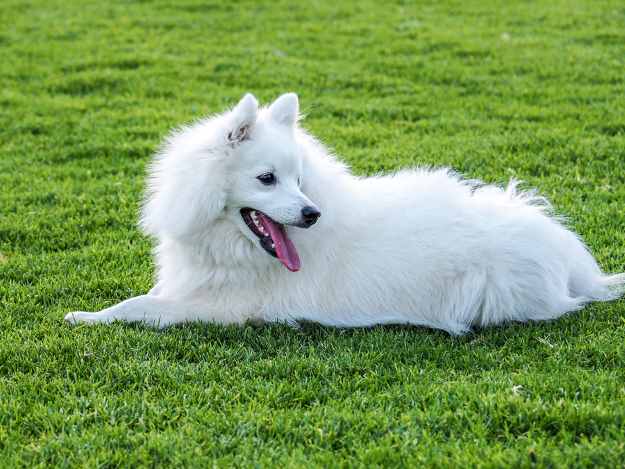
There seems to be some controversy over the origins of these dogs.
One theory suggests that the breed originated from the Siberian Samoyed. This theory suggests that the Samoyed was produced for smallness with the end result being the Japanese Spitz.
Even though this theory is controversial, the fact remains that the Japanese Spitz does appear to be the Samoyed’s little cousin.
The more accepted theory of their origins maintains that they were first developed in Japan in the 1920s and 1930s by using the white version of the German Spitz dogs. (German Spitz dogs come in a variety of different colors).
Other dogs including the American Eskimo were thrown into the mix.
Similar breeds were imported into Japan from Canada, the United States, Australia, and China. These dogs were used to create what is today known as the Japanese Spitz. The breed was first exhibited in a Tokyo dog show in 1948 and then recognized by the Japanese Kennel Club in 1948.
They were first imported into Europe in 1973 via Sweden. Others were introduced to other European countries shortly afterward.
They have gained recognition in most all English speaking kennel clubs including the FCI, except for the American Kennel Club. The AKC does not recognize this breed because it too closely resembles the white Pomeranian and the American Eskimo dog.
Temperament / Personality
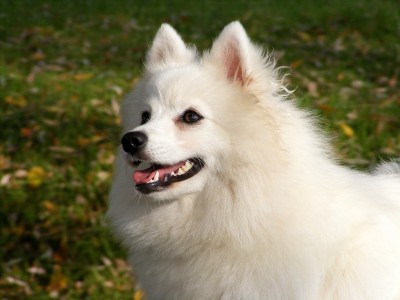
The Japanese Spitz is a high-spirited, high-energy dog. They love to play and are devoted to their family.
They do well with children and other pets, especially if they have been raised together.
They are a little reserved with strangers, but once they know you, they are happy to play and interact.
Their bold nature and their vocal tendencies make them excellent watchdogs.
They are intelligent and easy to train, assuming you establish early who the pack leader is. Less firm owners tend to discover their dog will take on the role of pack leader, which only leads to trouble.
Positive reinforcement works best with these dogs and a firm, but the gentle approach will get their attention and cooperation faster than force or coercion.
They are very active and will get some of their daily exercise indoors. They love walks and enjoy a romp in the yard. They are the perfect apartment size dog but remember they do have a tendency to bark so early socialization to curb this behavior is important if they are to live happily with you in an apartment.
The ideal owners for these dogs would be active singles, couples or families with children. They adapt to their owners and do well in urban, suburban and rural settings. The best owners will include the dog in their daily activities and make time for training, exercise, grooming, and play.
Grooming
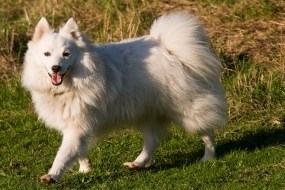
Even though these dogs have a thick coat, their grooming needs are surprisingly easy. They will need to be brushed and combed about once or twice a week.
Puppies should be brushed daily just to get used to the process. A little spray conditioner should be used before brushing.
Alternately, you can get a small water bottle and add a teaspoon or two of conditioner and mix thoroughly. The conditioner will help keep the dog’s hair from splitting and breaking. Any little mats that might have formed can be easily removed.
A slicker brush works best with this breed.
Most dirt will come out with brushing, but a monthly bath will keep them looking and smelling fresh.
The coat does best if it is dried with a blow dryer. Their coat does not get clipped, but the hair between their paw pads must be cut or shaved because it does continue to grow.
Nails need to be regularly trimmed and their teeth brushed.
Extra attention is needed when the dog is shedding. A metal comb or a rake works well to remove any dead hair.
They may need to be combed daily during the shedding season. This also helps keep hair from spreading everywhere in the house.
Health Concerns
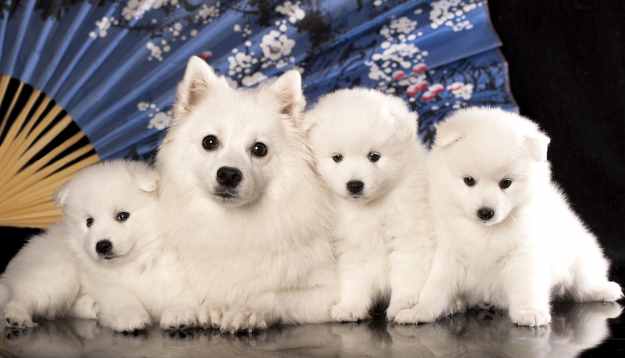
They are a fairly healthy breed with few genetic problems identified. Patellar luxation is one exception and is also common in many small breed dogs.
Patellar luxation is the condition where the kneecap moves in and out of the joint. It varies in severity and can be corrected, but it is best if Japanese Spitz breeders have their breeding stock checked for this condition prior to mating.
They can also have runny eyes that can cause staining. Washing the eyes with warm water each day helps, but if the tearing is caused by a medical problem such as blocked tear ducts, a trip to the veterinarian is warranted.
Pros
- Lively, happy dogs that are intelligent
- Easy to train
- Good watchdog
- Good with children and other pets
- Very healthy
- Grooming is relatively easy
Cons
- Can be barkers
- Need early training and socialization
- Not the dog for couch potato owners
About Janice (author and voice behind this site)
Having lived with dogs and cats most of her life, Janice served as a veterinary technician for ten years in Maryland and twelve years as a Shih Tzu dog breeder in Ohio.
Her education includes undergraduate degrees in Psychology with a minor in biology, Early Childhood Education, and Nursing, and a master's in Mental Health Counseling.
She is a lifelong learner, a dog lover, and passionate about the welfare of animals. Her favorite breed for over 50 years has been the Shih Tzu, but she has also lived with Poodles, Maltese, Yorkshire Terriers, Beagles, English Bulldogs, Carin Terriers, and a Cocker Spaniel.
When not writing, reading, and researching dog-related topics, she likes to spend time with her eight Shih Tzu dogs, husband, and family, as well as knitting and crocheting. She is also the voice behind Miracle Shih Tzu and Smart-Knit-Crocheting
Does This Article Deserve Your Thumbs Up?
We always appreciate your support and encouragement. Your thumbs up means so much to us. Please like this article.
If you find this page or any page on Small Dog Place Helpful, or useful in anyway, I'd love it if you would click the small heart found on the bottom right of each page.
You can also share or bookmark this page -- just click on the:

Free Monthly Newsletter
Sign Up for Our Free Newsletter and get our Free Gift to You.
my E-book, The Top 10 Mistakes People Make When Choosing a Dog (and how to avoid them)
